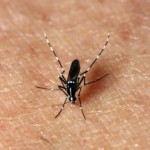Applicator Licensing Requirements in TX
Janis Reed, Ph.D., BCE, Extension Program Specialist, Texas A&M AgriLife Extension
Licensing questions are extremely common with applicators in Texas. Often applicators are unsure which type of license they need from of the Texas Department of Agriculture (TDA), an agriculture license or a structural license. Additionally, as outsourcing of services becomes more and more common, transitioning between utilizing using staff to manage pests, to hiring outside pest management companies can be confusing for both the pesticide applicators as well as administration. To make matters worse, changes in the licensing requirements that occur during outsourcing can confuse interested parties as well.
 A common conundrum faced by both applicators and administration is which type of license an applicator should obtain to apply pesticides around schools. In general, the answer is simple. If an applicator is going to make applications outdoors ONLY, to control turf pests and weeds, licensing through the TDA on the agriculture side is appropriate. In this case, the applicator should hold a license in the 3A category (Lawn and Ornamental). However, if pesticide applications are going to be made indoors or around buildings, with the intention to control structural pests, it becomes appropriate to be licensed through the Structural Pest Control Service and hold a license in the pest category.
A common conundrum faced by both applicators and administration is which type of license an applicator should obtain to apply pesticides around schools. In general, the answer is simple. If an applicator is going to make applications outdoors ONLY, to control turf pests and weeds, licensing through the TDA on the agriculture side is appropriate. In this case, the applicator should hold a license in the 3A category (Lawn and Ornamental). However, if pesticide applications are going to be made indoors or around buildings, with the intention to control structural pests, it becomes appropriate to be licensed through the Structural Pest Control Service and hold a license in the pest category.
Texas Department of Agriculture regulations allow non-commercial entities, such as school districts, food-processing establishments, and other institutions employees to hold a non-commercial applicators license. This license allows these employees to apply pesticides indoors in these facilities without direct supervision. A non-commercial applicator license is simpler to obtain than a commercial applicator license, especially if the applicator has no previous pest management experience or training. When an ISD outsources their pest management, the licensing and training requirements change significantly for the pesticide applicator. This is because, once this change happens, the applicator is no longer an employee of the ISD; they are an employee of the contractor. The contractor is then providing pest management services “for-hire” and for compensation. This requires the applicator to be licensed as a commercial technician or commercial certified applicator, and therefore meet the commercial applicator classroom and on-the-job training requirements.
In general, if the applicator has already been licensed by TDA as a non-commercial applicator, the license can be changed to a commercial designation, but only if the applicant has 12 months of experience. However, if an applicator does not meet these experience requirements or a new applicator is hired by the contractor, the commercial training requirements must be completed before a commercial technician license can be obtained.
A further burden placed on commercial applicators is supervision of any applicator that does not hold a certified applicator license. TDA regulations Rule 7.143 requires that until an applicator reaches the licensing level of certified applicator, he or she be required to contact a certified applicator a minimum of three days per week to fulfill the supervision requirements. This can be a challenge in rural districts or districts with only one or two pesticide applicators. This rule does not apply to non-commercial applicators.
Overall, pesticide applicator licensing can be confusing but there are many resources IPM coordinators, administrators, and applicators can utilize for answering questions. TDA staffs a helpline that is available 8-5 Monday through Friday for questions. The people staffing this helpline are well informed and extremely helpful. Our staff at the Pesticide Safety and Education Program with Texas AgriLife is a possible resource for help as well, and of course, the School IPM specialists with Texas AgriLife are particularly knowledgeable about licensing and pesticide applications around schools.
Have further questions?
Texas Department of Agriculture: 800-835-5832
Texas A&M AgriLife Pesticide Safety and Education Program: 979-845-1099
For more information about training requirements for commercial applicators: https://www.texasagriculture.gov/Portals/0/forms/PEST/Structural/Verifiable%20Training%20Record.pdf
AgriLife Extension entomologists: Avoidance, exclusion, repellents best practical defense against mosquitoes
Paul Schattenberg, Communication Specialist
Chikungunya, a viral disease transmitted by mosquitoes, has been identified in five Texas counties — four of them in South Central Texas — and may become endemic to the state, according to Texas A&M AgriLife Extension Service entomologists.
As far as the Texas cases are concerned, at this time it appears in each instance the disease was contracted in one of the countries where it is more common, said Sonja Swiger, AgriLife Extension entomologist at the Texas A&M AgriLife Research and Extension Center in Stephenville.

The Aedes albopictus or Asian tiger mosquito (shown here) is one of the two mosquito species known to commonly transmit chikungunya. The other is Aedes aegypti. Both species are found in Texas. (Texas A&M AgriLife Extension Service photo by Mike Merchant
“The first confirmed case of the disease in Texas was in Williamson County, and the most recent confirmed case was in Bexar County,” said Molly Keck, AgriLife Extension entomologist and integrated pest management specialist, Bexar County.
According to the Texas Department of State Health Services, cases have also been confirmed in Gonzales, Travis, and Harris counties.
The Centers for Disease Control and Prevention website notes chikungunya is not considered fatal, but can have serious symptoms, including severe joint pain and swelling, fever, muscle pain, headache and rash. Those most at risk are the very young; people over 65 and individuals with chronic medical conditions. The virus is not spread from person to person, and there is no treatment other than managing the symptoms.
Keck said the disease is fairly well known in Africa, Asia and Europe, but has more recently found its way into the Caribbean and the Americas.
“The bad news is that the insect species that commonly transmit chikungunya, the Aedes aegypti and Aedes albopictus mosquitoes, are found in Texas,” she said. “So we have the mosquito that vectors the disease and we have the host, humans. And since the disease pathogen is also present, we have all three components to potentially make the disease endemic.”
Endemic means being characteristic of or prevalent in a particular population, area or region.
“Since the virus is known to be in the area, people who have symptoms should go to a physician to determine what is causing their illness,” said Wizzie Brown, AgrLife Extension entomologist, Travis County. “A blood test is required to test for chikungunya.”
Brown said if people treat their symptoms at home without seeing a doctor, it can cause instances of the disease to be under-reported.
Keck noted it is “very likely” that chikungunya can become endemic to Texas, possibly on a greater scale than the West Nile virus.
“With West Nile, birds are the primary host and humans are the final or end host,” she explained. “The virus never reaches a high enough level in our bodies for a mosquito to pick it up from us. Therefore, there is a third player, birds, necessary for transmission of West Nile. But they are not necessary as a vector for chikungunya.”
Swiger said health officials now know of two cases in Florida where people were exposed to chikungunya locally, most likely through a mosquito vector.
“These individuals had not traveled to any of the areas where the disease is prevalent,” Swiger said. “At this point, it seems like just a matter of time before the virus spreads more widely in the U.S.”
She said both Aedes aegypti and Aedes albopictus mosquitoes can carry the disease, but A. aegypti is primarily found in the southern U.S. while A. albopictushas has a much greater geographic range.
Mapping of the two species by the Centers for Disease Control and Prevention shows A. aegypti is found in scattered areas of the southern U.S., whereas A. albopictus, or the “Asian tiger mosquito,” is found widely dispersed throughout the south central, southeastern and mid-Atlantic regions of the country.
For more information about chikungunya, go to http://www.cdc.gov/chikungunya/.
“While there’s not much you can do about chikungunya if you get it, there’s still much you can do to prevent mosquito bites in the first place,” Keck said. “For example, if you’re planning to travel to the Caribbean or one of the countries where chikungunya is more common, be sure to pack some insect repellent to reduce your risk of contracting the disease.
“And now that we have confirmed cases in Texas, it would also be wise to apply insect repellent anytime you spend time outdoors, not just during dawn and dusk when mosquitoes are typically the most active. The mosquito species that transmit chikungunya are extremely active during the day.”
Keck said the most effective repellents are those containing DEET.
“Repellents with up to 30 percent DEET are usually safe for young children, but should
not be used on babies or infants,” she said. “Extension recommends repellents approved by the EPA and recommended by the CDC for their ability to effectively repel mosquitoes for extended periods of time. These include DEET, picaridin, IR3535 and oil of lemon eucalyptus.”
If you need to be outside, try to wear light-colored, loose-fitting shirts or tops with long sleeves and pants, she said.“It helps to spray repellent on your clothes too,” Keck added.
Swiger said aedes mosquitoes lay their eggs on moist ground around the edges of water or the inside walls of artificial containers. After water accumulates, the eggs become submerged and hatch.
“If conditions are too dry when the eggs are first laid, they will die,” she explained. “But if the embryo can develop before it gets too dry, the eggs can withstand adverse conditions for long periods.”
Keck said to help prevent mosquito proliferation, homeowners should empty any containers, tires, buckets, bags, birdbaths or other items that may capture rainwater and become a mosquito breeding ground.
“During the hot months, mosquitoes can go from egg to adult within a week; be sure to dump standing water at least every three days,” she said. “You can also exclude mosquitoes by keeping doors and windows fully closed and making sure screen doors close tightly and don’t have any holes or tears in them.”
Janet Hurley, an AgriLife Extension school integrated pest management specialist in Dallas, suggested emptying plastic wading pools weekly and storing them indoors when not in use.
“You should also remember to repair leaky pipes and outside faucets and fill any holes or depressions in trees with sand or mortar,” she said.
Hurley said another way to help reduce adult mosquito populations is to mow tall grass areas and reduce the amount of brush or other foliage to eliminate some adult mosquito resting sites.
“You can also consider fog treatment or surface treatments for temporary relief in yards or high-traffic areas,” she said. “But only use insecticides that are labeled for that purpose and apply them according to product label directions.”
The entomologists said that while taking these measures may not keep someone from being bitten by mosquitoes, they could significantly reduce the number of bites, which will reduce the chance of becoming infected by a mosquito-borne disease.
For More Information check out our eXtension website here
Just in time for school: New pest control calculator now available for maintenance professionals
Steve Byrns, Communication Specialist
Maintenance professionals gearing up for the start of school now have a new tool to help defend students from the inevitable summer influx of undesirables roaming the halls.
The Texas A&M AgriLife Extension Service’s new integrated pest management website, http://ipmcalculator.com, offers school staff members in charge of pest control a wealth of practical information on managing rodents, birds, cockroaches, ants and a plethora of other unwelcome denizens, said Janet Hurley, AgriLife Extension integrated pest management program specialist at Dallas.
 “The cost calculator, available free on the website, allows the user to assess various pest risks on their school and district levels,” Hurley said. “The resulting information will be a big help for those responsible for developing a budget for a school integrated pest management program.”
“The cost calculator, available free on the website, allows the user to assess various pest risks on their school and district levels,” Hurley said. “The resulting information will be a big help for those responsible for developing a budget for a school integrated pest management program.”
Hurley said using the calculator is as simple as entering the school’s location, presence of pests and the facility’s condition. The calculator then gives an overall pest risk estimate for the school.
“The calculator also has features that allow you to create your own budget to see how improving certain features will affect the overall pest risk,” she said.
The cost calculator doubles as an excellent teaching tool because many aspects of general building maintenance also relate to pest issues, Hurley said.
“The bottom line with this calculator is that it allows the user to see the impact different building budgeting plans, past, present or future, have had or will have on the facility’s pest risk profile,” she said. “Just as investors use spreadsheets to study the impact of various investment strategies, the pest calculator helps pest management coordinators maximize the most ‘bang for their buck’ of currently budgeted dollars, or in some cases, helps them to justify requests for adding to those budgets.”
Hurley said the IPM Cost Calculator is part of a website developed by the Southwest Technical Resource Center for School Integrated Pest Management, and cooperating states with financial support from the U.S. Department of Agriculture’s Southern Region Integrated Pest Management program, http://www.sripmc.org/ . She suggested visiting the integrated pest management site at http://ipm.tamu.edu/ to learn more about integrated pest management.


 .
.